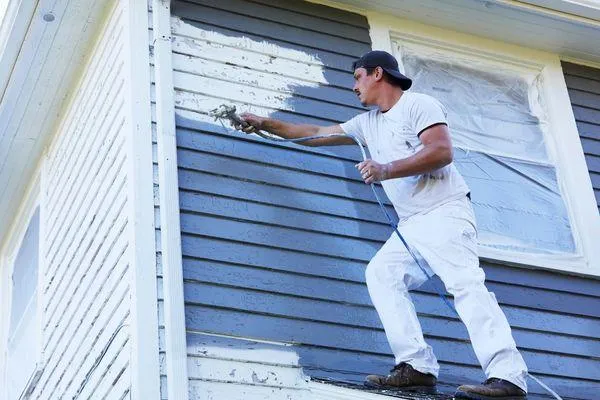
How Exterior Painting Can Boost Your Home’s Curb Appeal
Introduction
First impressions matter, and your home’s exterior is the first thing visitors and potential buyers see. A well-maintained exterior reflects pride of ownership and significantly enhances your home's curb appeal. One of the most effective ways to achieve this is through exterior painting. Whether you’re preparing to sell or want to enjoy a more attractive home, exterior painting can make a dramatic difference.

“Boosting your home's curb appeal with exterior painting isn't just a facelift; it's an investment in protection and value. Discover the best practices, from selecting the right paint to deciding between DIY and hiring professionals, to ensure your home stands out.” - Right Now Cleaning
The Importance of Curb Appeal
The Psychological Impact of a Well-Maintained Home
Curb appeal is more than just aesthetics; it’s about the emotional response it evokes. A well-maintained exterior can instill a sense of pride, security, and happiness in homeowners and guests alike. A fresh coat of paint can transform a tired-looking facade into a welcoming, vibrant space that leaves a lasting impression.
How Curb Appeal Affects Home Value
Real estate experts agree that curb appeal has a substantial impact on property value. Homes with high curb appeal often sell faster and at a higher price compared to those with neglected exteriors. Exterior painting is a relatively affordable way to boost your home’s marketability and overall value.
Benefits of Exterior Painting
Immediate Visual Transformation
One of the most immediate benefits of exterior painting is the visual transformation. It can make an old house look new again, modernize outdated colors, and even correct architectural flaws. The right color palette can highlight your home’s best features and create a cohesive look that stands out in the neighborhood.
Protection from the Elements
Exterior paint serves as a barrier against the elements, protecting your home from moisture, UV rays, and temperature fluctuations. Quality paint can prevent wood rot, mildew, and other forms of deterioration, extending the lifespan of your siding, trim, and other exterior components.
Increased Home Value
Investing in exterior painting can yield a high return on investment (ROI). Potential buyers are more likely to be attracted to a home that looks well-cared for, and a fresh coat of paint can be a deciding factor in making a purchase. Even if you’re not planning to sell, the increased property value is a significant benefit.
Choosing the Right Paint
Types of Exterior Paints
Selecting the right type of paint is crucial for durability and aesthetics. There are several types of exterior paints to consider:
Latex Paints: Known for their durability and easy cleanup, latex paints are a popular choice for exterior applications. They are flexible and can withstand varying weather conditions.
Oil-Based Paints: These paints offer a smooth finish and excellent adhesion but are less flexible than latex paints, making them more prone to cracking in extreme weather.
Acrylic Paints: These are highly durable and provide a good balance between flexibility and adhesion. Acrylic paints are also resistant to fading, making them ideal for sun-exposed areas.
Color Selection Tips
Choosing the right color for your home’s exterior can be daunting. Here are some tips to help you decide:
Consider Your Home’s Style: Traditional homes often look best with classic colors like white, beige, or gray, while modern homes can handle bolder shades.
Neighborhood Aesthetics: Ensure your color choice complements the surrounding homes. This maintains harmony in the neighborhood and can also help with resale value.
Test Before Committing: Paint small sections of your exterior to see how the colors look in different lighting conditions before making a final decision.
Eco-Friendly Options
For environmentally conscious homeowners, eco-friendly paint options are available. These paints have low or no volatile organic compounds (VOCs), reducing environmental impact and improving indoor and outdoor air quality.
Preparation for Exterior Painting
Cleaning and Repairing Surfaces
Proper preparation is key to a successful paint job. Start by cleaning the exterior surfaces to remove dirt, mold, and old paint. Pressure washing can be an effective method for this. Next, inspect the surfaces for damage. Repair any cracks, holes, or rot before painting to ensure a smooth, durable finish.
Priming for Perfection
Applying a primer is essential, especially on new wood or bare surfaces. Primer helps paint adhere better and provides a uniform base, enhancing the paint’s durability and appearance. Choose a high-quality primer that is compatible with your paint type.
DIY vs. Professional Painting
Pros and Cons of DIY
Painting your home’s exterior yourself can be a cost-effective option, but it comes with challenges. DIY painting requires time, effort, and skill to achieve professional-looking results. Mistakes can be costly and time-consuming to fix. However, it can be a rewarding project if you’re up for the challenge and have the necessary tools and knowledge.
Advantages of Hiring Professionals
Hiring professional painters offers several advantages. Professionals have the experience, skills, and equipment to complete the job efficiently and effectively. They can provide expert color advice, ensure proper surface preparation, and deliver a high-quality finish. While it may be more expensive upfront, the investment can save you time, stress, and potential do-overs.
Common Mistakes to Avoid
Skipping Surface Preparation
One of the most common mistakes in exterior painting is skipping surface preparation. Proper cleaning, repairing, and priming are crucial for a lasting paint job. Neglecting these steps can lead to peeling, cracking, and premature paint failure.
Ignoring Weather Conditions
Weather conditions play a significant role in the success of an exterior paint job. Avoid painting during extreme temperatures, high humidity, or rainy weather. Ideal conditions include mild temperatures and low humidity, which allow the paint to dry and cure properly.
Maintenance After Painting
Regular Cleaning
To maintain the fresh look of your exterior paint, regular cleaning is essential. Wash your home’s exterior annually to remove dirt, dust, and mildew. Use a gentle cleaning solution and a soft brush or cloth to avoid damaging the paint.
Handling Chips and Peels
Over time, you may notice small chips or peels in the paint. Address these issues promptly to prevent further damage. Sand the affected areas, apply a primer, and touch up with matching paint to maintain the integrity of the finish.
Exterior Painting Trends
Popular Colors for Modern Homes
Modern homes often feature bold, striking colors that make a statement. Dark blues, greens, and even blacks are popular choices for a contemporary look. Neutral colors like gray and beige are timeless and versatile, providing a sophisticated and clean appearance.
Finishing Techniques
Finishing techniques such as color blocking, accent walls, and textured finishes can add depth and character to your home’s exterior. These techniques allow for creative expression and can highlight architectural features or create visual interest.
Cost Considerations
Budgeting for Exterior Painting
Exterior painting can be a significant investment, so it’s important to budget accordingly. Consider the cost of paint, supplies, and labor (if hiring professionals). Obtain multiple quotes from contractors to ensure you’re getting a fair price. Don’t forget to factor in potential repairs and prep work.
Cost vs. Value
While the initial cost of exterior painting can be substantial, the value it adds to your home often outweighs the expense. A well-executed paint job can increase your home’s curb appeal, protect it from the elements, and boost its market value.
Frequently Asked Questions
How often should you repaint the exterior of your home?
The frequency of repainting depends on several factors, including the type of paint used, climate, and the quality of the previous paint job. On average, homes should be repainted every 5-10 years.
What is the best time of year to paint your home?
The best time for exterior painting is during mild weather, typically in spring or fall. Avoid painting in extreme heat, cold, or rainy conditions for optimal results.
How do I choose the right color for my home’s exterior?
Consider your home’s architectural style, surrounding environment, and personal preferences. Testing colors on small sections and observing them in different lighting can help in making the right choice.
Can exterior painting protect my home?
Yes, exterior painting provides a protective barrier against moisture, UV rays, and temperature changes, preventing damage and extending the life of your home’s exterior materials.
How long does exterior paint typically last?
High-quality exterior paint can last between 5-10 years, depending on environmental conditions and maintenance. Regular upkeep can extend the paint’s lifespan.
Is it necessary to prime the exterior before painting?
Priming is essential for bare surfaces or when changing from a dark to a light color. It ensures better paint adhesion and a smoother finish, enhancing the durability of the paint job.
Conclusion
Exterior painting is a powerful tool for enhancing your home’s curb appeal, protecting it from the elements, and increasing its value. By choosing the right paint, preparing surfaces properly, and considering professional help, you can achieve a stunning and long-lasting transformation. Regular maintenance and staying updated with trends will keep your home looking its best for years to come.


